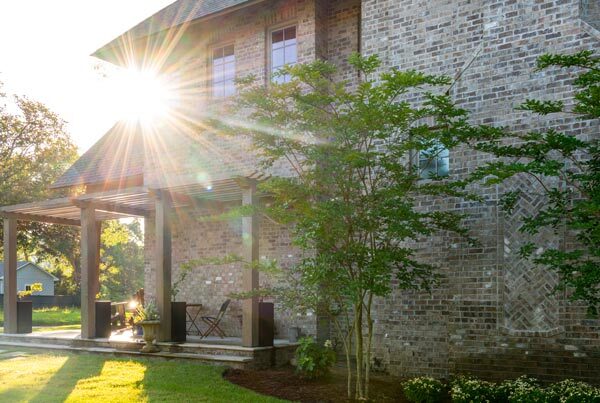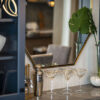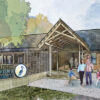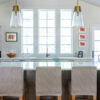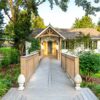The Health Benefits of Nature and How To Support Our Natural Spaces
“Nature is not only nice to have, but it’s a have-to-have for physical health and cognitive functioning.” (Yale, 2020)
In recent years, scientific and scholarly journals have increasingly reported on the health benefits of nature. It may seem like common sense that fresh air and exercising outdoors are good for your health, but in the past 30 years a growing body of research on the benefits of nature contact has started to influence the planning and design of buildings and communities.
At WATERSHED, we use evidence based design strategies to create buildings that support both human and environmental health. We think it is vital to plan for ecological restoration and conservation at every scale, from individual buildings, to campus, to community.
This is one of the many reasons we support the important work of the South Alabama Land Trust, which works to protect and preserve critical landscapes in coastal Alabama while providing environmental education for current and future generations. Formally known as the Weeks Bay Foundation, this non-profit organization started in 1990 to support the Weeks Bay National Estuarine Research Reserve in its efforts to conserve the pristine coastal area of Baldwin County, Alabama. In 2009, they became a Nationally Accredited Land Trust.
In the following article from their quarterly publication, The SALT Line, contributor Colette Boehm recognizes the importance of meeting the current watershed moment head-on with responsible conservation and construction practices that increase access to nature for communities across South Alabama.
Photo: Colette Boehm, Dauphin Island Bird Sanctuary
The Health Benefits of Nature
Reprinted with permission from the Summer 2021 issue of the SALT Line magazine.
—
Is This Our Watershed Moment?
Watershed moment: def: reaching a place where the landscape turns in a new and different way, a defining moment, a pivotal moment, a turning point
Everybody loves a great view. But researchers are finding out more and more about the value of views of, and particularly proximity to, natural areas. They could be lifesavers!
Research also estimates that by 2050, 66 percent of the developed world will be urbanized, which, unfortunately, will distance more and more people from nature and undisturbed lands. This means the work of SALT and organizations like it are vital in turning the tide at this watershed moment. Preservation and restoration can play a crucial role not only in the environmental arena, but also in positively impacting people’s health.
Local architect and LEED Fellow Rebecca Bryant has built a company that works with design and construction teams to create healthy buildings and landscapes that conserve energy and resources while fostering a greater connection to the natural world. The term Biophilic Design is used for projects that create a greater sense of health and well-being for inhabitants by maximizing natural elements. The practice has also been found to have beneficial financial implications that result from improving health and well-being.
But such improvements still pale to the benefits of actually immersing in natural areas. Compared to exercise indoors or in outdoor built settings, studies show exercise in natural green spaces results in people “reporting a greater sense of well-being or exhibiting greater concentration or restoration.”
Natural areas, trees in particular, have been proven to increase property values and provide numerous valuable ecosystem services. Increasing numbers of architects, landscape designers and city planners have recognized this and, as a result, are incorporating natural spaces into their plans. Further, more and more research is showing that it’s not just property and land use concerns that are positively impacted by natural areas. It’s people, too. Our most valuable asset, our health, can benefit in many ways.
Consider these findings from the American Public Health Association:
“People of all ages and abilities enjoy higher levels of health and well-being when they have nature nearby . . . Access to nature has been related to lower levels of mortality and illness, higher levels of outdoor physical activity, restoration from stress, a greater sense of well-being, and greater social capital.”
Another study finds:
“For both adults and children, encounters with everyday nature restore the ability to concentrate, calm feelings of anxiety and reduce aggression. Views of natural settings reduce the number of sick days taken by office workers and decrease hospital patient recovery time.” – Landscape and Urban Planning 1986
These natural elements include trees, diverse vegetation, local biodiversity and water features, among others. It’s believed that even short visits of five minutes around trees or in green spaces may improve health.
This growing volume of data is proving that protecting and restoring access to nature can be vital to human health, with benefits that include:
- boosting the immune system
- lowering blood pressure and reducing stress
- improving mood
- increasing ability to focus, even in children with ADHD
- accelerating recovery from surgery or illness
A study in the United Kingdom actually shows that an increased proximity to trees reduces the amount of prescribed anti-depressants (Urban street tree density and antidepressant prescription rates—A cross-sectional study in London, UK).
Chattanooga-based physician and Baldwin County native Dr. Suzanne Corrington said she sees her support of SALT as a way to help ensure those benefits continue for generations to come.
“Natural areas sustain us,” she said, noting the positive health benefits research has revealed. “It’s important to save what we can.” Preservation efforts, she said, are the best ways to do what we can to protect the land and natural resources that benefit us in so many ways.
Through the support of professionals like Rebecca Bryant and Suzanne Corrington and so many others, SALT is making efforts to meet this watershed moment head on and preserve the healing, natural areas of south Alabama. – Colette Boehm



